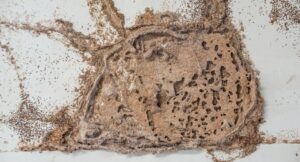Mud nests are most commonly built by insects like mud dauber wasps or certain types of termites. These nests are often found in sheltered outdoor areas such as under eaves, in garages, sheds, attics, or even on walls. While mud nests are fascinating architectural feats of nature, they can be unsightly, attract unwanted pests, and may pose a risk of stings if the nest is active. In this article, we will explore how to remove mud dust from your home.
How to Remove a Mud Nest?

Before you begin the removal process, it’s essential to identify whether the nest is active. Look for insect activity, if you see wasps flying in and out frequently, the nest is likely in use. Always prioritize safety and consider calling a professional if you’re unsure.
Here’s how to safely remove a mud nest:
- Wear Protective Clothing: If dealing with wasps, wear long sleeves, gloves, and ideally a face mask or shield to protect yourself from potential stings.
- Choose the Right Time: Early morning or evening is best for removal, as insects are less active during cooler hours.
- Spray Insecticide: If the nest is active, use a wasp or insect-specific spray to eliminate the inhabitants. Follow the instructions on the can carefully and retreat to a safe distance after spraying.
- Wait and Observe: Give it at least 24 hours to ensure all activity has stopped before removing the nest.
- Physically Remove the Nest: Use a scraper, putty knife, or stiff brush to knock the nest off the wall or surface. Collect the remains in a sealed bag and dispose of it properly.
- Clean the Area: Wash the surface with soapy water or a mild bleach solution to remove scent markers that might attract future nest builders.
How to Prevent from Mud Nest?

Prevention is key to keeping your home mud-nest-free. Here are a few tips:
- Seal Cracks and Gaps: Insects often build nests in small cracks or crevices. Seal entry points around windows, doors, vents, and eaves.
- Use Natural Repellents: Essential oils like peppermint, eucalyptus, and citronella can deter wasps. Spray these in high-risk areas regularly.
- Install Mesh Screens: Cover vents and openings with fine mesh to block entry.
- Keep Outdoor Areas Clean
Remove spider webs, cobwebs, and debris regularly to make the environment less appealing for insects. - Apply Residual Insecticides: In areas with frequent problems, consider using a long-lasting insecticide on surfaces where nests have been previously built.
Conclusion
Removing a mud nest can be a straightforward process if done with care and proper precautions. Whether you’re dealing with a small dauber nest or something more substantial, understanding how to safely remove and prevent them is essential. Always consider pest control services experts for help with large or persistent infestations.






